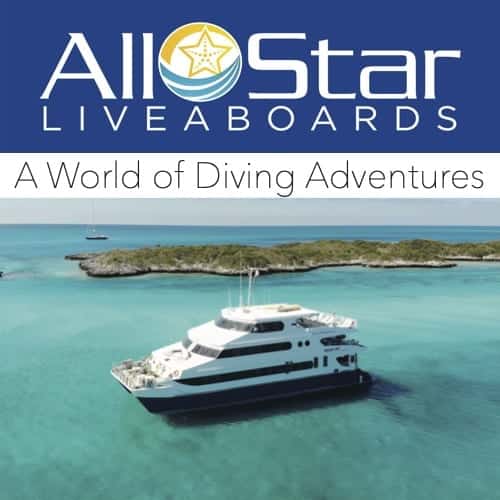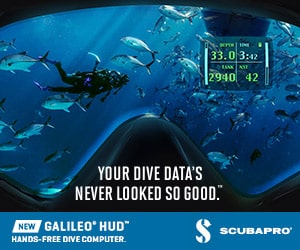Diving Blue Heron Bridge in Palm Beach County Florida is considered one of the best shore dives in America. It offers easy access and a wide variety of fish. In fact, many people report over 100 species of fish sighted on a single dive! Combine this with a unique snorkeling trail, and you will see why you have to scuba dive Blue Heron Bridge for yourself.
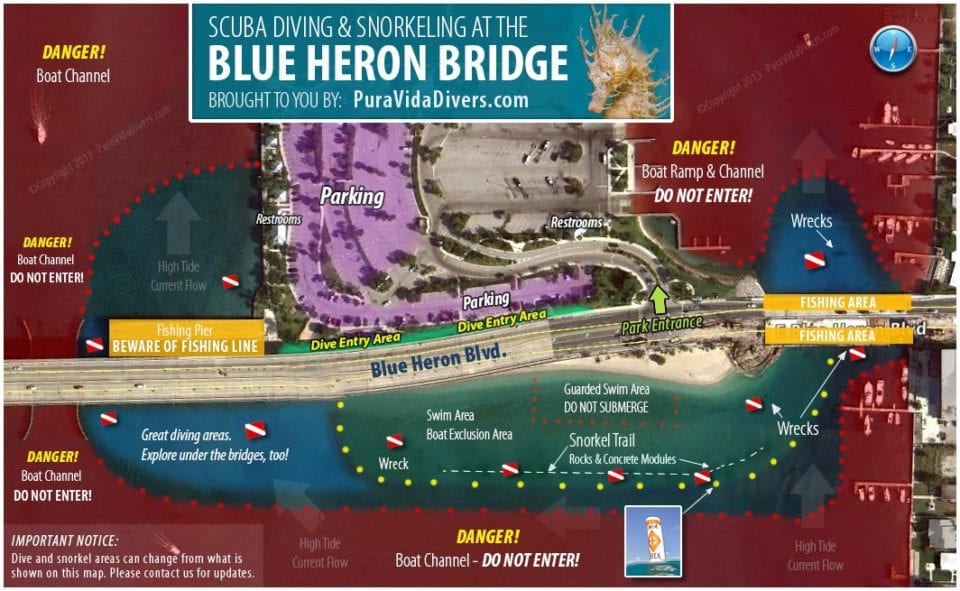
Things to Know about Diving Blue Heron Bridge
- Dive Map for Blue Heron Bridge – Pura Vita Divers provided the dive map above. Notice where you can and can’t scuba dive. At the end of this list, I’ll share a Blue Heron Bridge dive plan.
- When is the best time to dive Blue Heron Bridge? You have to dive BHB during slack high tide. Since this is a shallow dive, you can spend up to two hours underwater. Aim to get in the water two hours before high tide, so the current (and visibility) stays good. Make sure you check the tide tables before you go.
- What fish can you see at Blue Heron Bridge? The Lake Worth Lagoon ecosystem is very diverse. You can see up to 100 different fish species on the same dive! You might see octopus, striated frogfishes, fly gunyards, purple morays, cardinalfishes, molly miller blennies, octopi, sea horses, and all kinds of gobi. Check out Blue Heron Dive Club’s Facebook page for the recent critters spotted.
- Where is Blue Heron Bridge? – Blue Heron Bridge is accessed at Phil Foster State Park, 900 East Blue Heron Boulevard, Riviera Beach, FL 33404.
- What are the hours of Phil Foster Park? Phil Foster Park is open sunrise to sunset except for boat launches.
- Can you night dive at Blue Heron Bridge? Night dives are allowed by permit only. Several local dive shops, including Pura Vida Divers (conveniently located near the bridge), get permits for night dives. Check in at the BHB night dive schedule to see when you can hop on the trip for free.
- Do you need a dive flag at BHB? Absolutely. You will need a diver’s flag which can be purchased or rented at any dive shop. The flag is red with a white stripe from the upper left corner to the lower right corner.
- How is the visibility at Blue Heron Bridge? It can be up to 100′ during high slack tide. You can call a local dive shop (Like Pura Vida Divers – 561-840-8750) to check on current conditions because some days viz can be too low to dive.
- Can I spearfish at Blue Heron Bridge? No spear guns are not permitted at Blue Heron Bridge. Signs indicate collecting of tropical fish by any means is prohibited. BHB is a unique habitat and should be treated like a wildlife preserve – no touching and no collecting, please.
- Who was Phil Foster? Phil Foster was the former mayor of Riviera Beach responsible for securing the funding and resources that make the Phil Foster Park possible. Check out this link to learn more about the fascinating history behind Phil Foster Park and the Blue Heron Bridge.
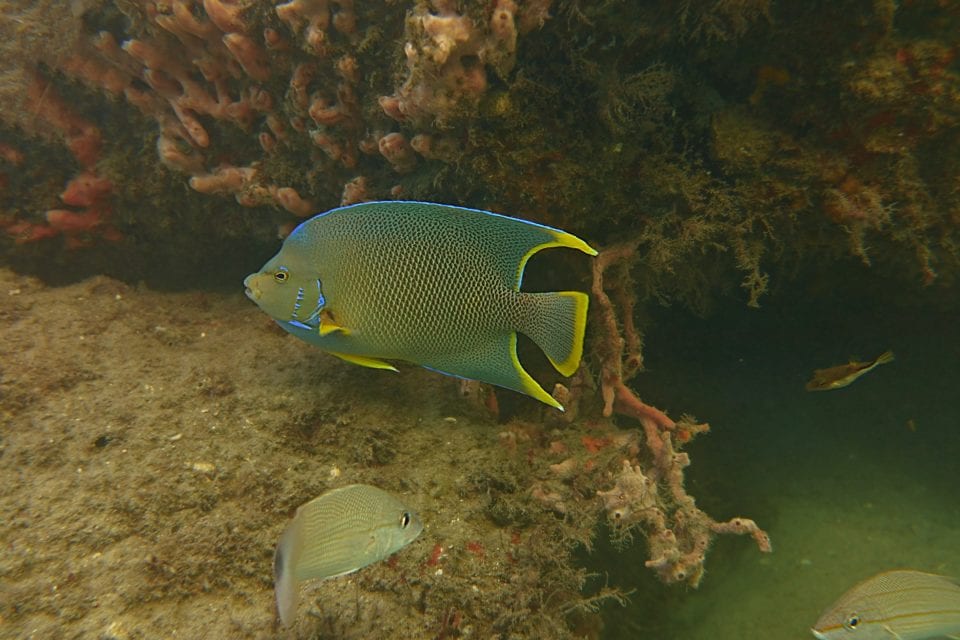
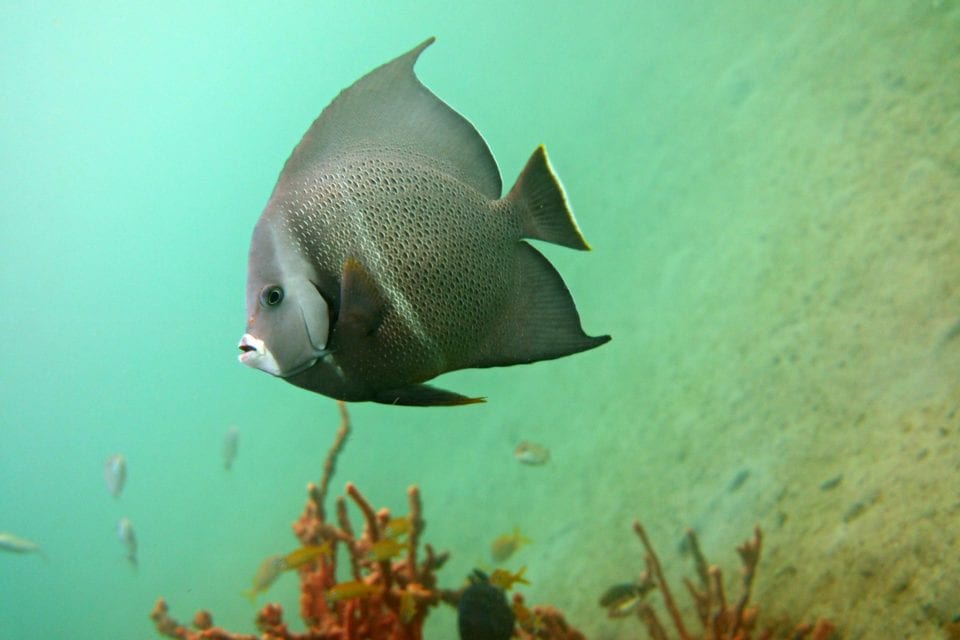
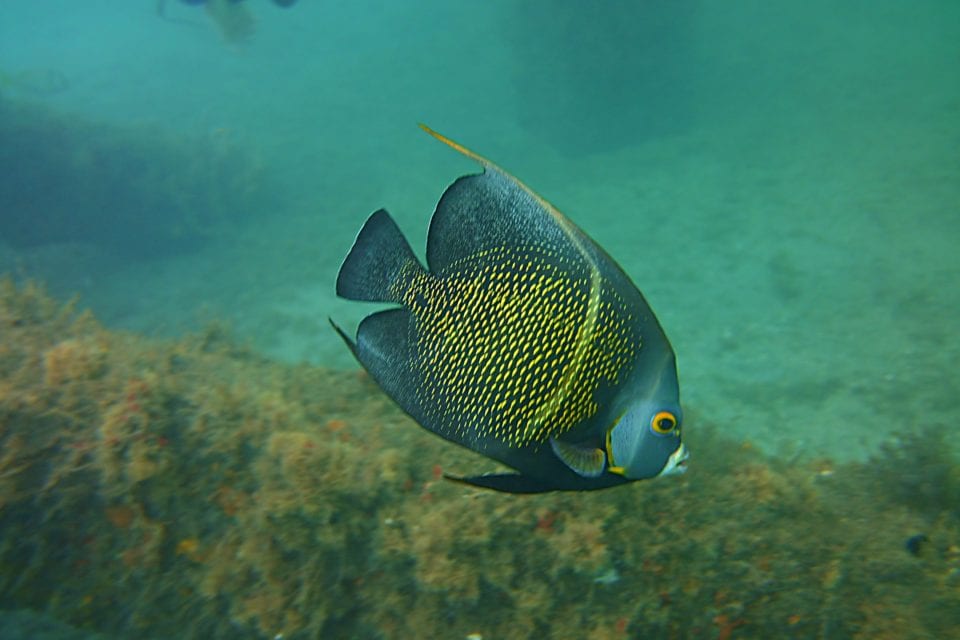
Dive Plan for Blue Heron Bridge
The primary concerns to be mindful of diving at Blue Heron Bridge are current and boat traffic. To mitigate current make sure you dive during high slack tide. To mitigate boat traffic bring a diver down flag and stay out of the boat channels. BHB can be a very long dive because of the shallow depth so make sure you have enough thermal protection. Maximum dive depth less than 25′. Plan for a one tank dive of 90 – 120 minutes.
Enter the water on the east side of the guarded swim area in front of the playground. Depending on tides and current, you may want to swim in the snorkel area or head directly to the bridge pilings. There is minimal swimming to reach either location. The bridge pilings are an excellent opportunity to see lots of fish, but they are also subject to the most current so plan your bridge time to coincide with the least amount of current (closest to high tide) during your dive. Reaching the bridges is an excellent chance to test your underwater navigation skills because you have to round the corner as you pass the island. Be mindful of fishing line around the fishing pier which is just past the bridge. It would be good to have a line cutter or knife where you can reach it just in case.
The snorkel trail is made up of limestone boulders and prefabricated reef modules. It spans a two-acre area in 6 to 10 feet of water with 600 tons of rock in the reef. The most important feature is that these rocks are about 10′ apart, so you should be able to see from one cluster of rocks to the next. Look for a few specialty reefs around the trail like shopping carts and some small sunken boats. If you reach the shark statue, be careful because you are nearing the boat channel. Strong currents may exist, and if you overshoot, you might end up in traffic.
You can exit the water on either side of the swim area, but it’s easier to return to where your car is parked. There are two fresh water showers to rinse off by either exit. You will want to leave the park before it closes to avoid getting a ticket.
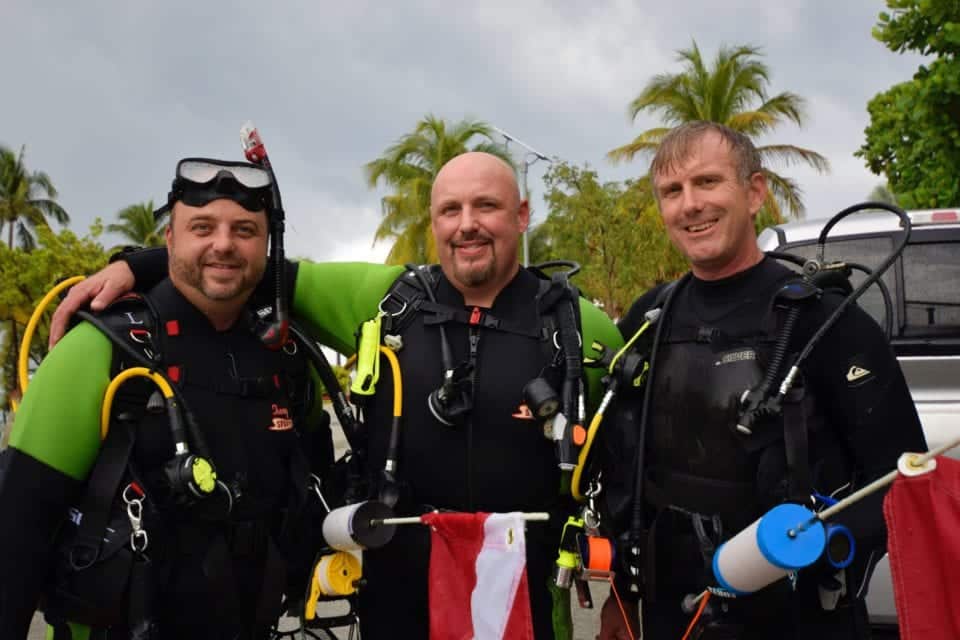
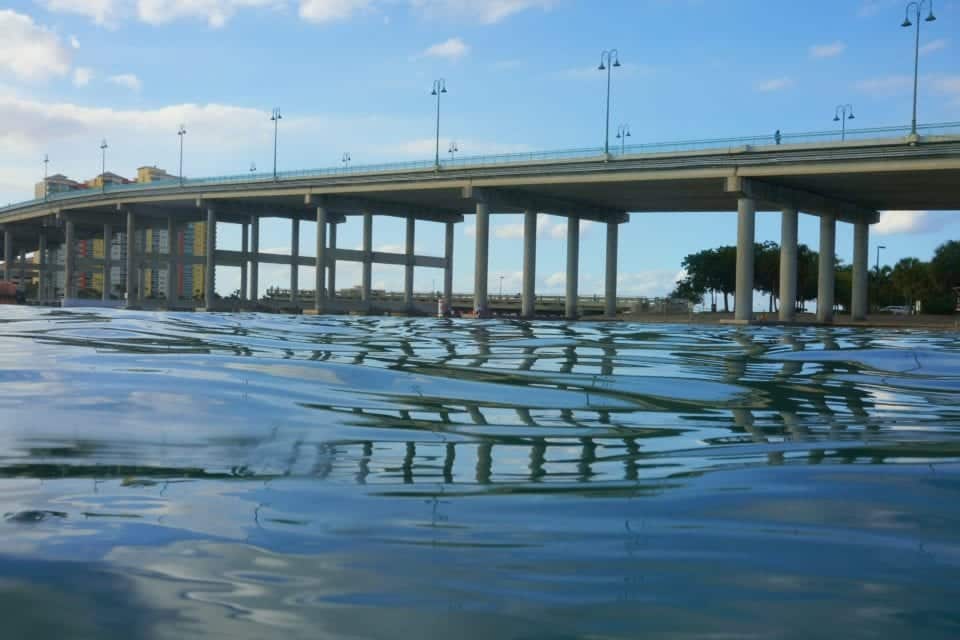
Our Dive at Blue Heron Bridge – Reaching the Bridge
Jenn completed her Advanced Open Water up in Crystal River a couple of weeks ago, which is where we met our new friends Curtis and Mike. They’re salt of the earth transplants from Ohio. The kind of guys who are self-reliant with minimal egos. In other words, excellent dive partners. I have a feeling you’re going to be reading about quite a few adventures with Mike and Curtis in the future.
The prior day, we made a shore dive to the Pompano Drop Off down in Fort Lauderdale that consisted of a half hour surface swim each way. We were all a little spent, so gearing up was an adventure in itself. We entered the water with about 30 minutes to go till high tide. We choose to go to the West Bridge first and save the snorkeling trail for when the tide is going out.
There are a few people in the world who are, let’s politely say, navigationally challenged underwater. I have a goal next year of getting my DM, and the first thing I am buying is an air integrated computer with a digital compass. Until then, I just let Mike lead. He looked at the bridge and estimated 250 kick cycles before his turn. I thought he was joking, but he led us right to the pilings without popping up for reference.
Dive theory states that the largest buoyancy swings occur in shallow water. Swimming to the bridge in 6′ of water without kicking up silt can be challenging. I was impressed with everybody’s buoyancy. It wasn’t long before we started seeing critters on the flats, like giant starfish and trunkfish. This section of the swim was interesting, but certainly not world class. The ranking dramatically changed when we reached the bridge.

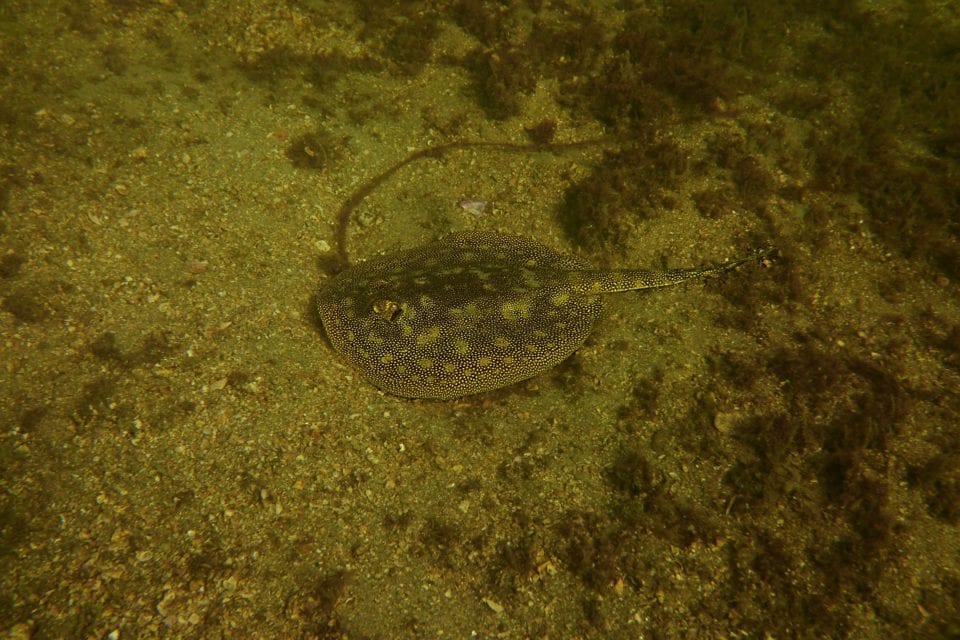

Our Dive at Blue Heron Bridge – Exploring Bridge Pilings and Rubble Field
When Mike hooked north to the bridge, the first thing I noticed was the deeper water. Descending to 20′ gave me that weightless feeling I love about diving. I pointed my light into the narrow space between the bridge pilings. The eyes of innumerable creatures stared back at me. Giant schools of tropical fish flowed beneath the bridge like a river underwater.
The highlight of the dive was a rubble pile just north of the bridge. Here we discovered a pair of moray eels and the usual reef fish like grunts, angelfish, and parrotfish hanging out. Now I know how Blue Heron Bridge got its reputation as a world-class shore dive.
Knowing what I know now, I might have spent longer beneath the bridge. The depth, clarity, and variety of life made this the highlight of the dive for me. However, we were in the exploring mood and wanted to check out the Snorkeling Trail.
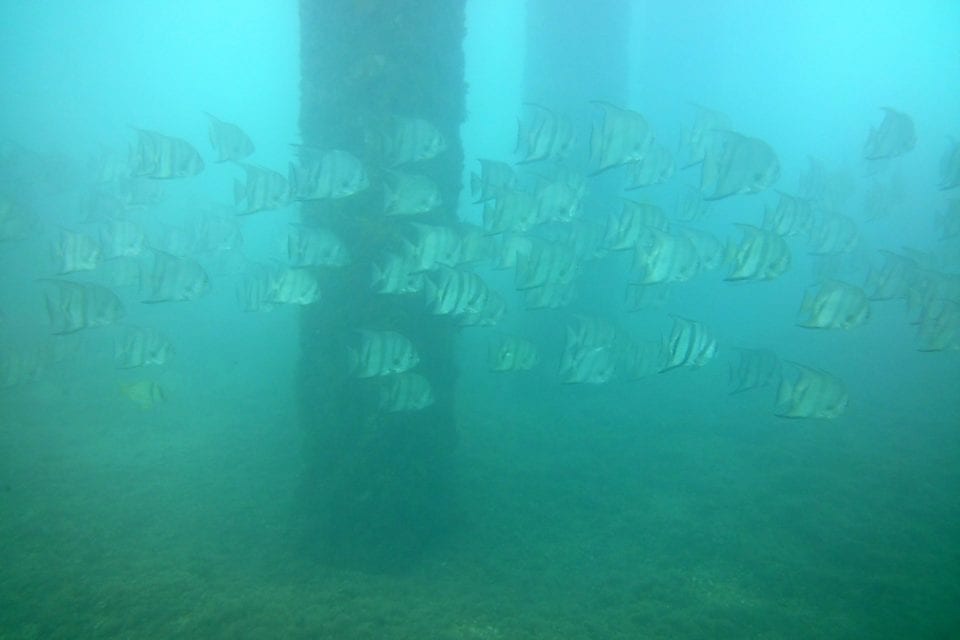
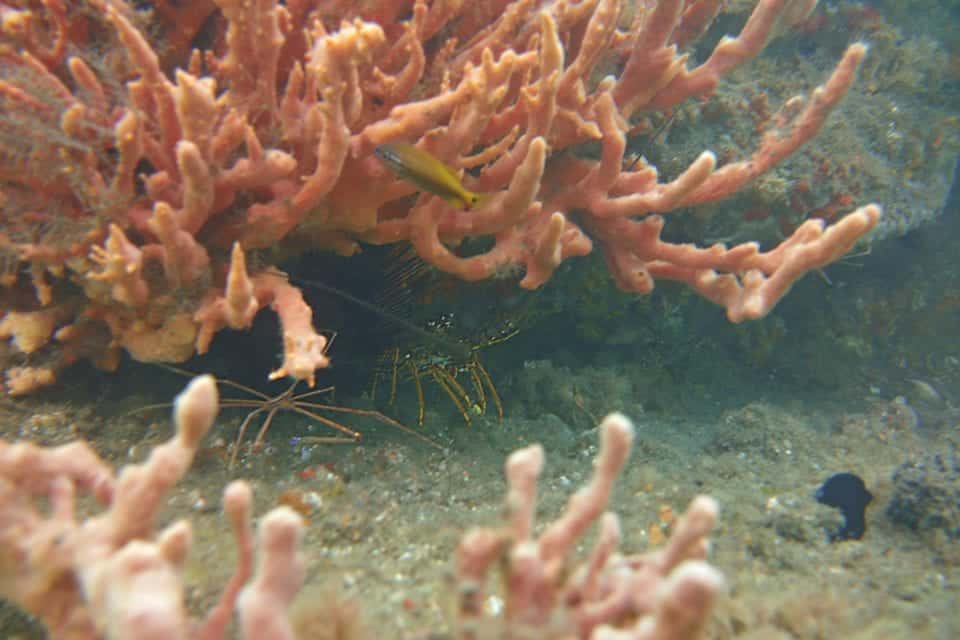
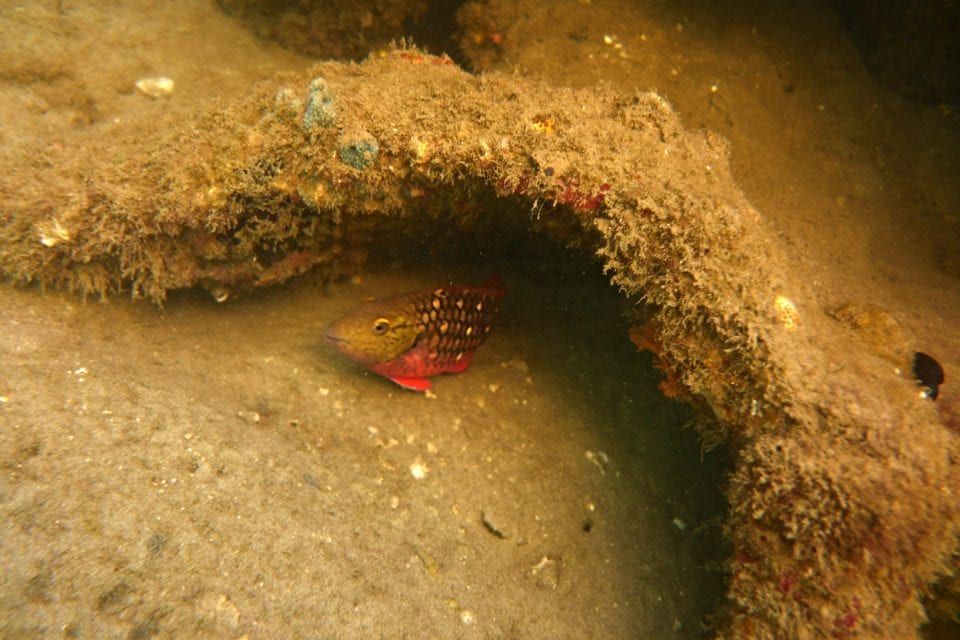
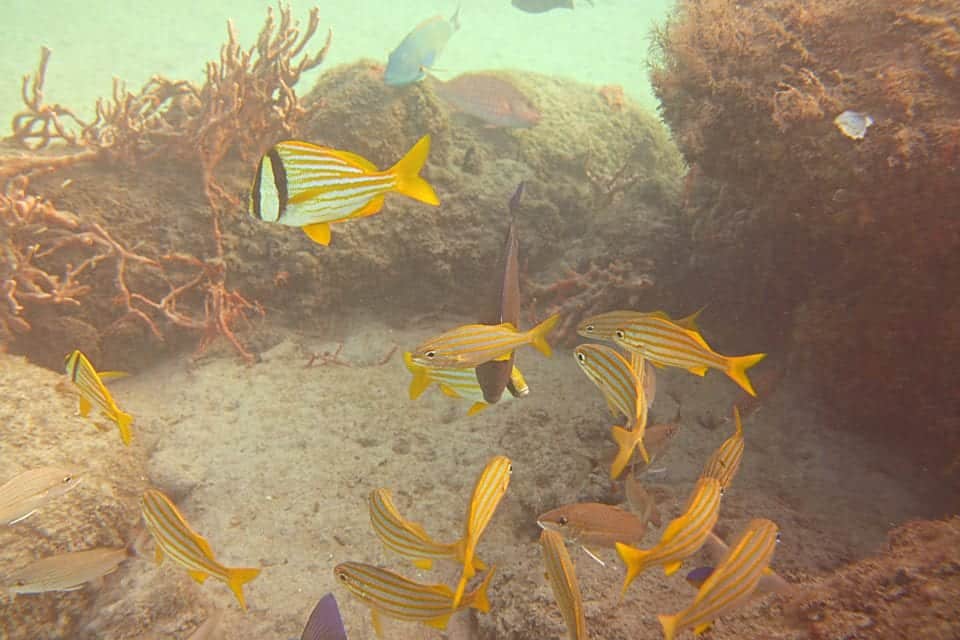
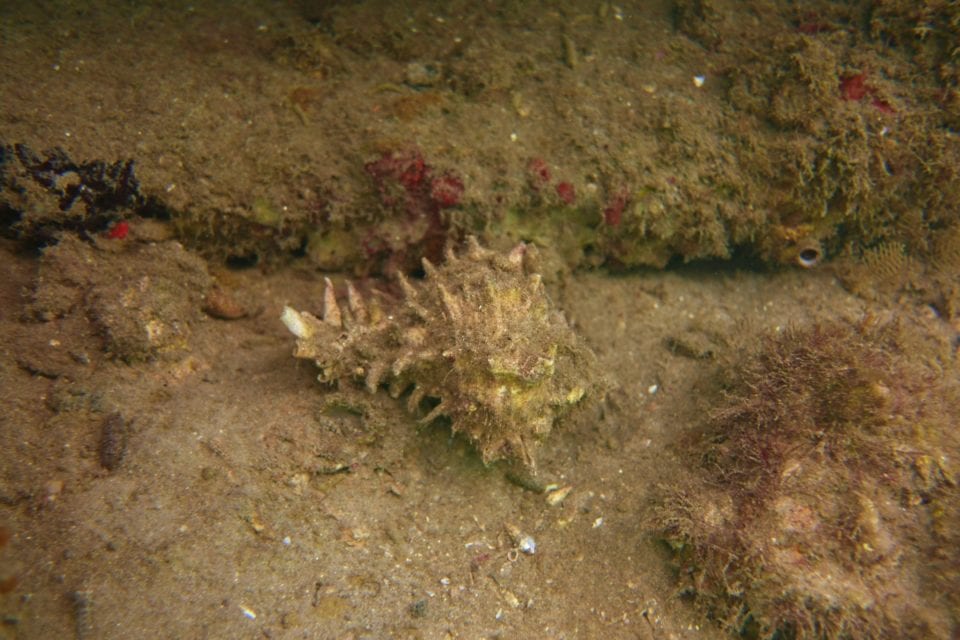

Our Dive at Blue Heron Bridge – the Snorkeling Trail
It bears repeating that Mike is an excellent navigator. He took us right back to where we started. His beeline navigation cut off the north-west corner of the dive area, which is where you find the shopping cart, shark statues, and an excellent seahorse habitat. We look forward to picking those up next time.
It also bears repeating that, not only were we shagged out from the previous dive, but we also had a bit of car trouble that had us rushing to the bridge. Curtis’ dive plan called for switching tanks halfway through. We waited at the surface for a couple of minutes at the first rock pile for him to return. This dive plan shows just how convenient it is to dive at BHB, but we would have been much better served to come early and be better prepared. For one, we could feel the current kicking up just a bit. For two, the vis was dropping as the outgoing tide cycled out the clear Atlantic water with the murky soup of the Lake Worth Lagoon.
After reuniting on the surface, we followed the snorkel trail counter clockwise. Visibility was still good enough to navigate between rock outcroppings. Each outcropping had a numbered plaque so we could easily tell where we were on the trail. The trail was interesting enough seeing the collections of fish and juvenile lobster at each location. The sunken speedboat was kind of cool too. What made this section special was that we were diving late enough in the day to have the night fish come out and play. Pretty soon we were spotting groups of barracuda at each station. I can only imagine what a full night dive must be like here.
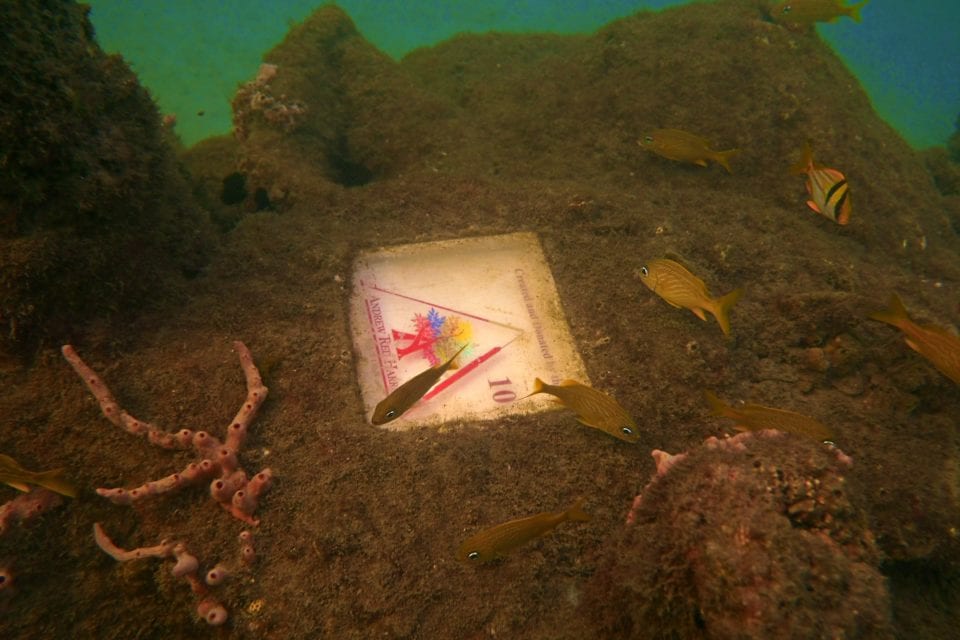


Our Dive at Blue Heron Bridge – Exiting the Water
Curtis and Mike left the water first after about 90 minutes. They popped up, and surface swam back to the beach. Jenn and I decided to take the snorkel trail back around to the start. I was diving with my steel 120 tank, so I had plenty of air left – even at the 2-hour mark. Jenn has fabulous air consumption, so she was still doing ok even with an aluminum 80. It’s just that we were both getting cold and the visibility had dropped enough that we could no longer see the next rock pile. After about 20 more minutes in the water, Jenn and I called it and headed back to shore with extra air in our tanks. Our bottom time was about 2 hours on our dive.
We learned some valuable lessons for next time. We are going to make sure that we are ready to dive when that 2-hour before the slack tide window opens. We’ll ask the shop to top off Jenn’s A-80 before the dive. We dove in December, and the chill forced us out early. If the season calls for cooler water temperatures, I’ll bring my hood and maybe even my thicker wetsuit. There are also enough nooks and crannies to justify bringing my big dive light on every dive.
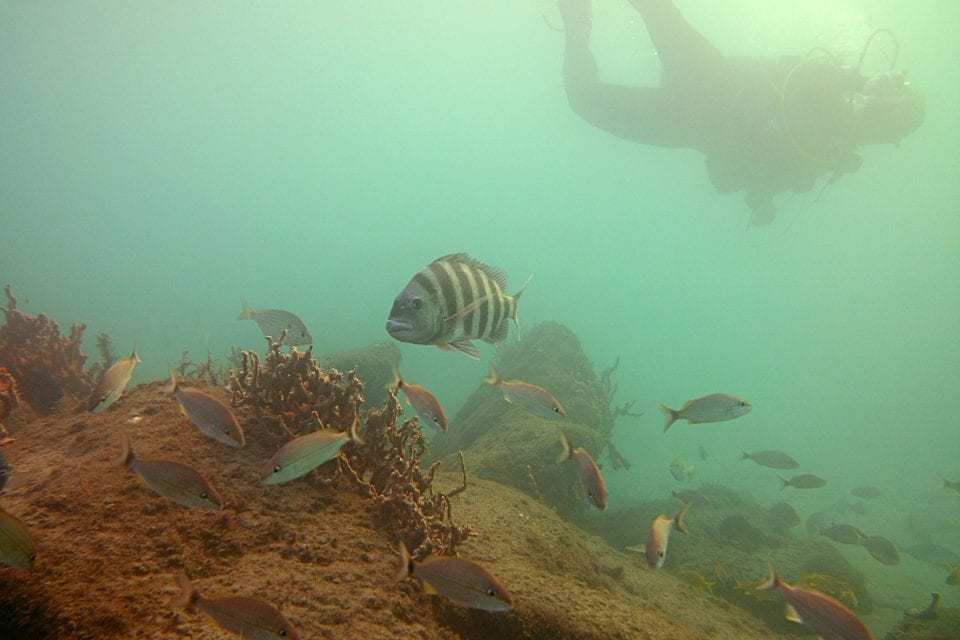

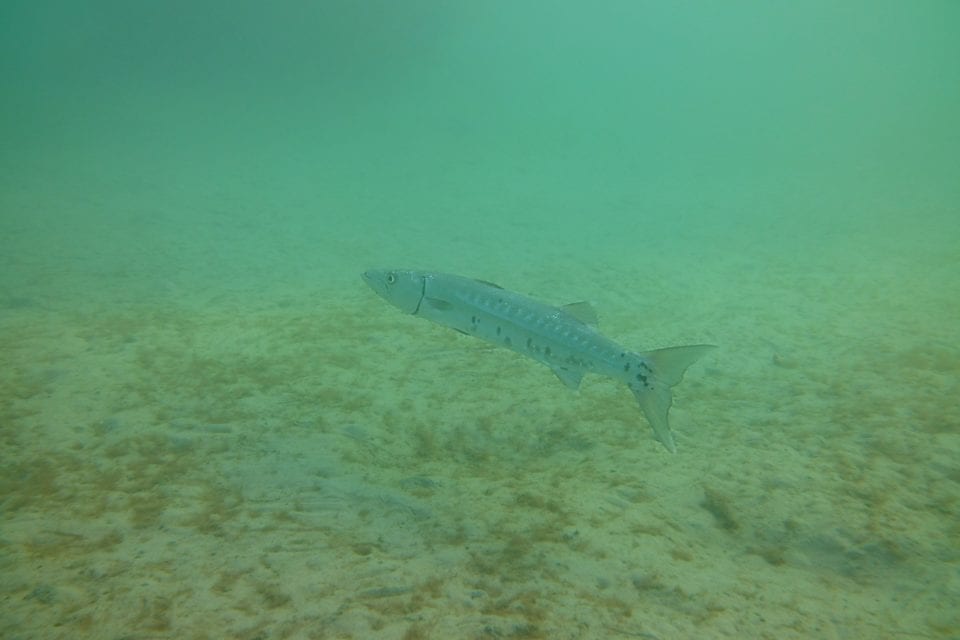
Diving Blue Heron Bridge FAQs
Can you dive Blue Heron Bridge?
Yes, absolutely! In fact, it’s something any diver who visits the area should experience.
How deep is the water at Blue Heron Bridge?
The depth at the bridge ranges from 4 feet (entry point) to 20 feet near the boat wrecks. The snorkel trail ranges from 10 to 15 feet in depth.
Do you need a dive flag to snorkel Blue Heron Bridge?
Anyone snorkeling or diving must have a dive flag to mark their location in the water.
Final Thoughts on Diving Blue Heron Bridge
Blue Heron Bridge lived up to its reputation as an incredible shore dive. We rank it right up there with Casino Point on Catalina Island; only it’s a lot easier to reach. If you’re anywhere in south Florida with dive gear, like Fort Lauderdale, you should consider taking a shore dive at Blue Heron Bridge
Underwater photographers call this a muck dive because you’ll find critters living in the sediment at Blue Heron Bridge that you will not see at the reefs or wrecks. With a little tide planning and maybe targeting a night dive, you should be able to tack on a BHB trip with a 2-tank boat dive. A lot of shops rent gear for 24 hours so you might be able to do both dives with the same gear rental. You always have to keep the tide levels in mind, but you’ll be rewarded with diverse sea life and beautiful pictures in shallow, clear water.
Where to Stay near Blue Heron Bridge
Ready to Book Your Trip? These Links Will Make It Easy:
Airfare:
- Find low fares and book your flight with Expedia, WayAway, CheapOair, or Trip.com
- Grab your airport parking reservation from The Parking Spot
- Stay overnight at an airport hotel and park for free with Park Sleep Fly
- Enjoy your time at the airport at a Priority Pass Lounge
Car Rental:
- Need to rent a car? Discover Cars will get you on the road without breaking the bank!
- If you are brand loyal, you can also book directly through Alamo Rent-A-Car or Thrifty Rent-A-Car
Lodging:
- We loved staying and the beautiful all-inclusive Sandals Royal Curacao and we think you will too! Book your Sandals getaway now!
- From hotels to private homes, find the perfect accommodation with Hotels.com, VRBO, Expedia, or Booking.com.
- You can also book direct through Hilton Hotels
Insurance:
- Protect your trip and yourself with World Nomads and Medjet
- Safeguard your digital information by using a VPN. We love SurfShark as it is superfast for streaming Netflix
- Stay safe on the go and stay connected with an eSim card through AloSIM
Like it? Pin it for later on Pinterest!
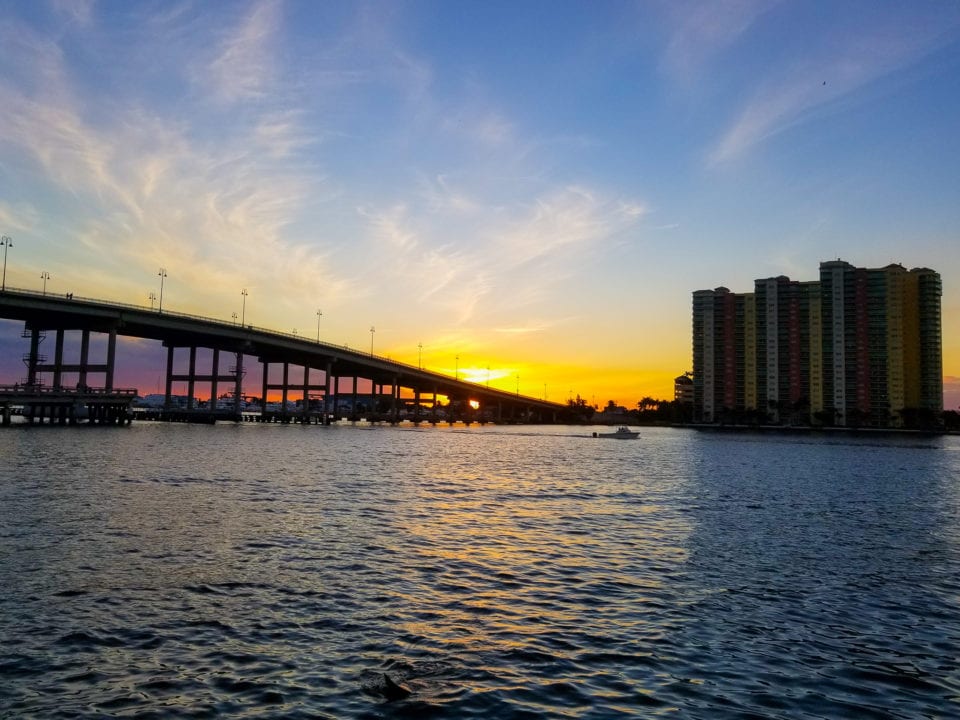
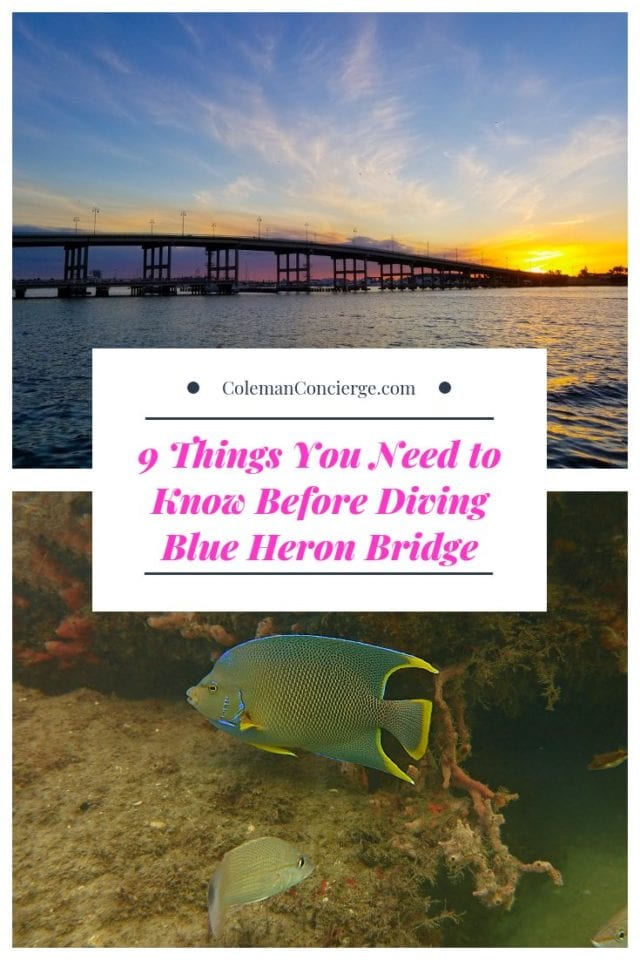
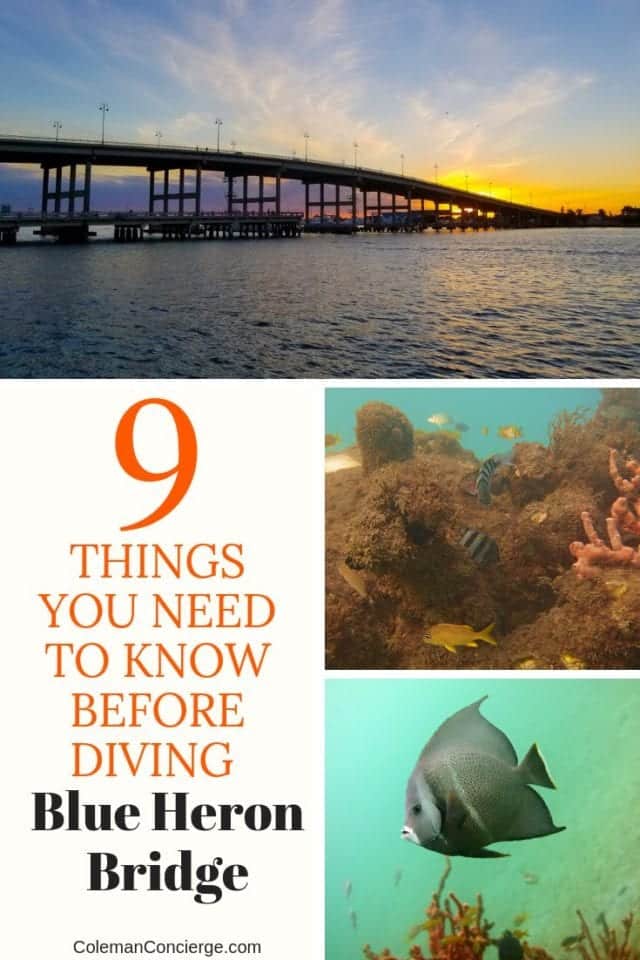
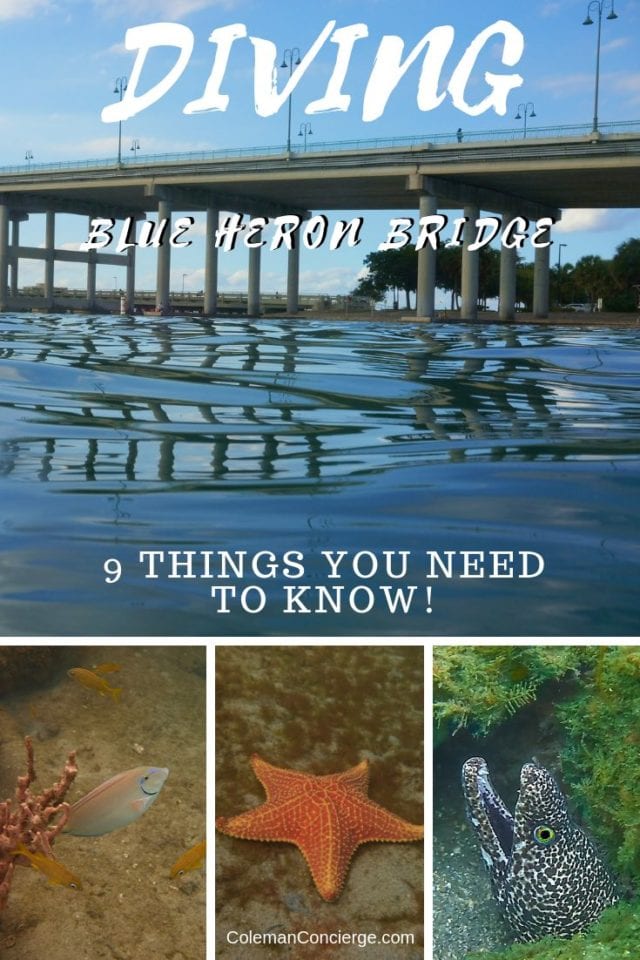
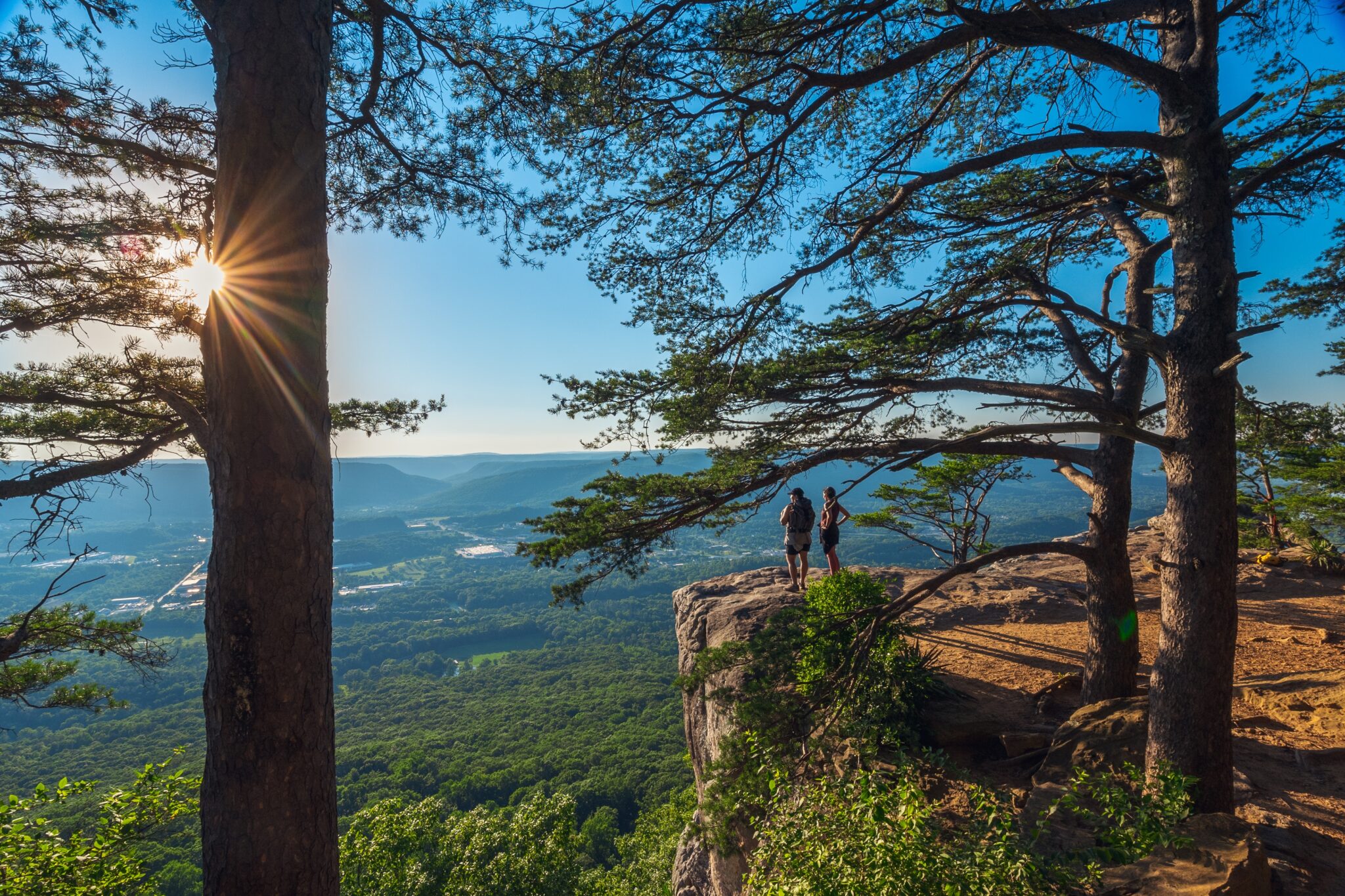
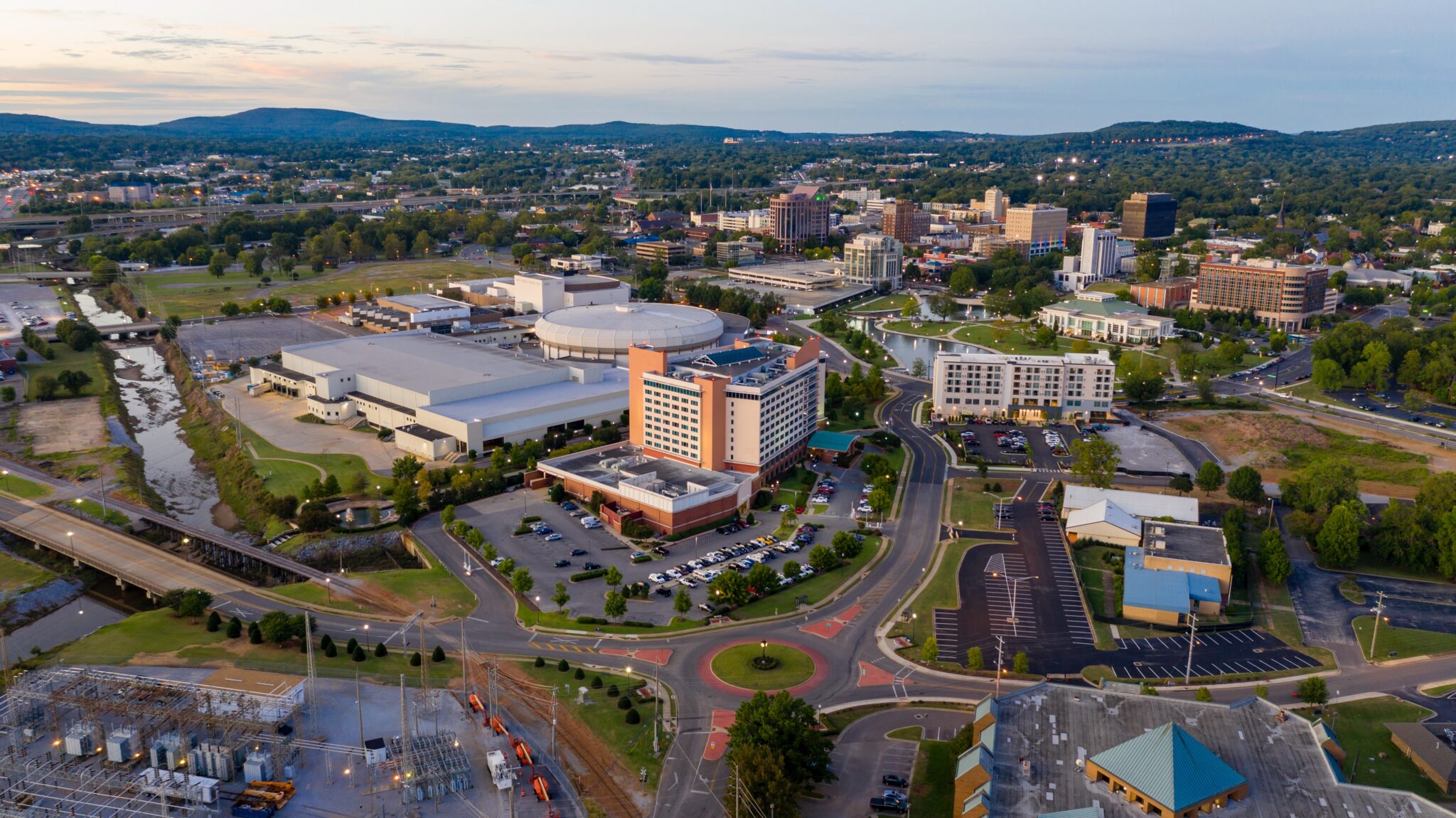
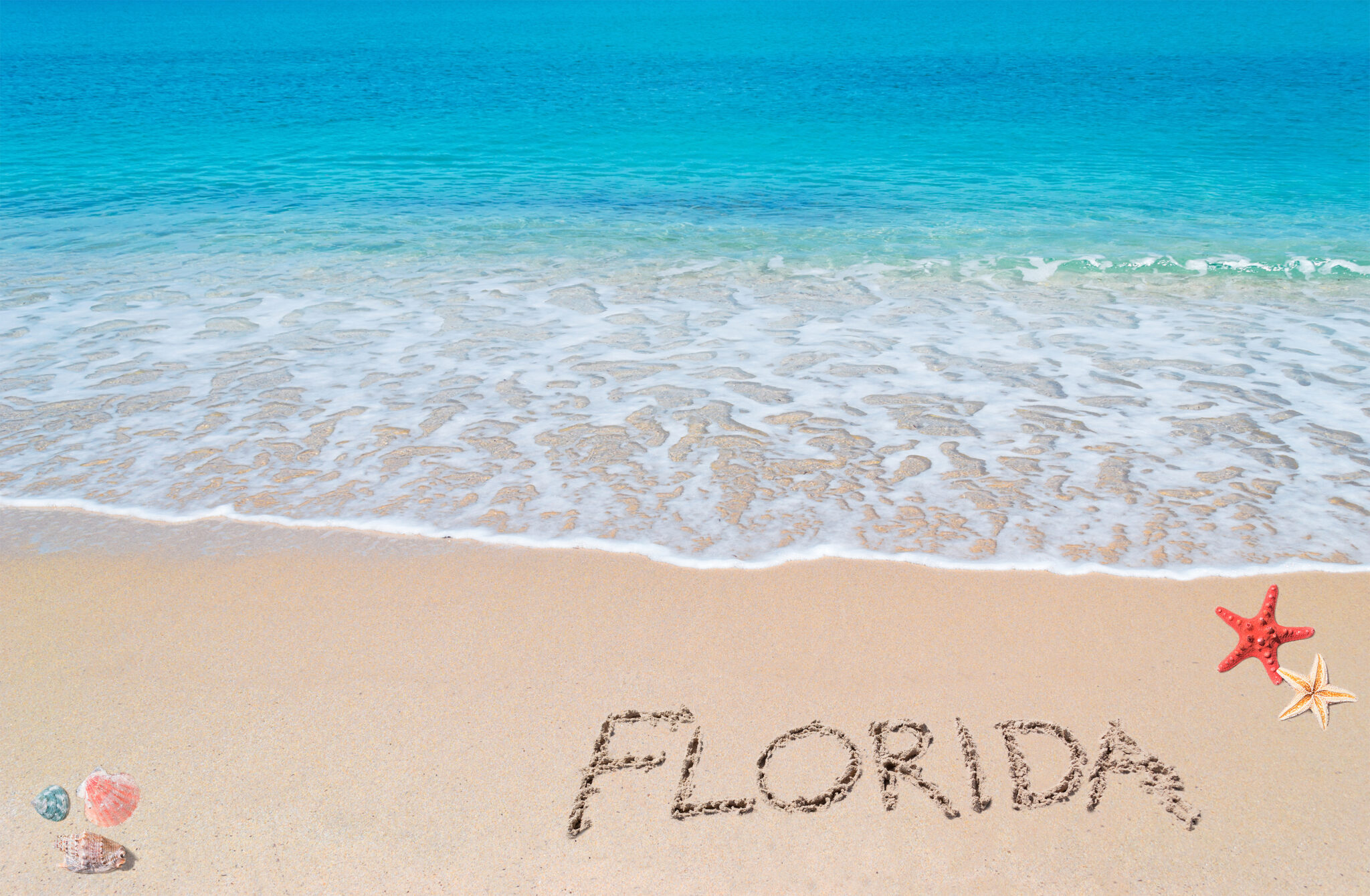
 Hi! We are Jenn and Ed Coleman, and together we are Coleman Concierge. It is our goal to inspire you to get out, expand your world, and to seek adventure, even in your own backyard.
Hi! We are Jenn and Ed Coleman, and together we are Coleman Concierge. It is our goal to inspire you to get out, expand your world, and to seek adventure, even in your own backyard.






